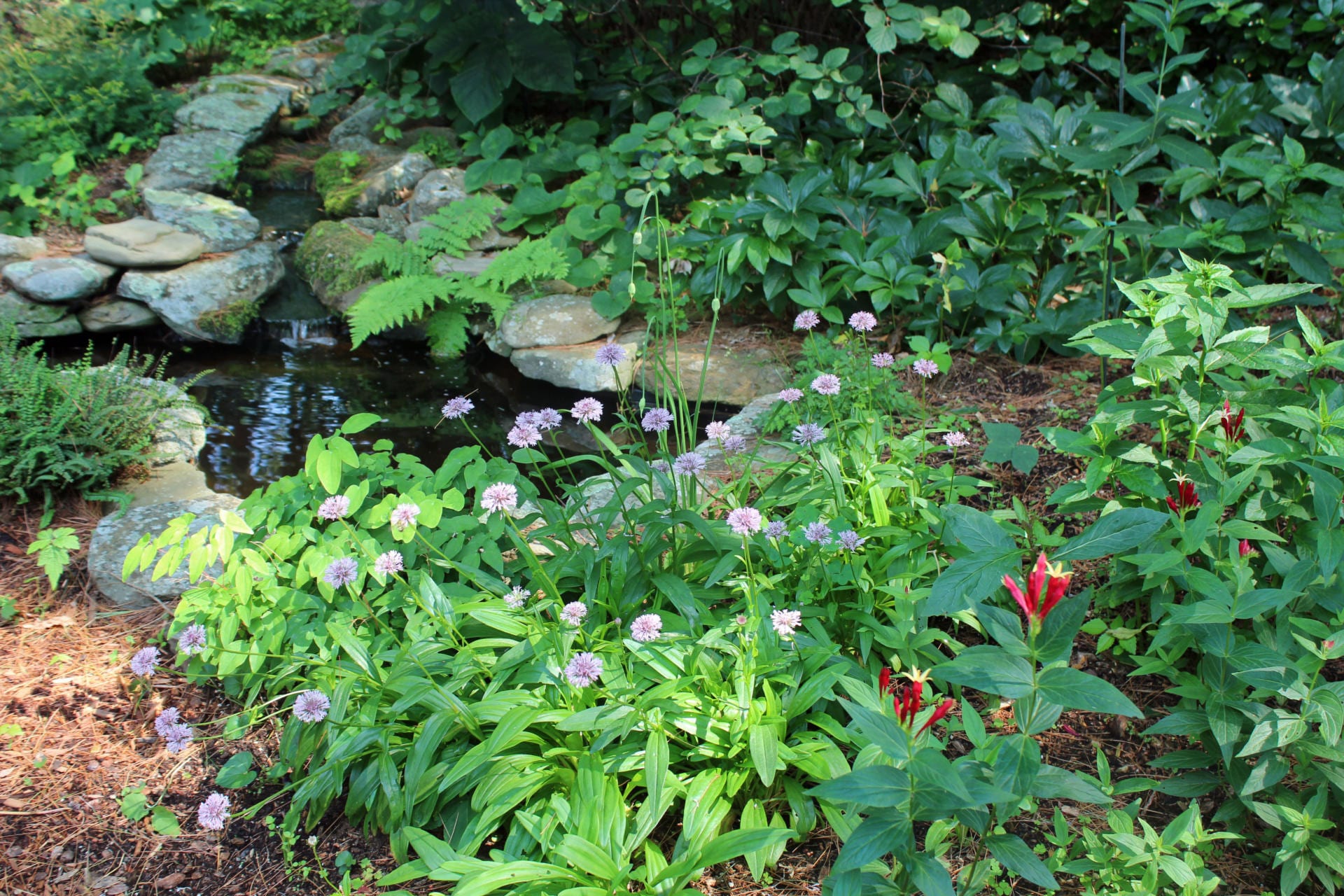by Bruce Patterson
The wise advice gardeners often hear is to “plant in the habitat type where the plants are naturally found. Be sure to select plants that prefer the habitat (or microhabitats) of your garden.” Sometimes that good advice conflicts with the vision we have for our gardens.
Garden Site
In 1990 when we purchased our home in North Andover, MA, my wife, Roberta, and I envisioned establishing a woodland garden over the quarter acre at the back of the property. The site for our garden was part of a White Pine – Oak Forest spilling into our backyard. The tree layer, dominated by oak and white pine and including some red maple, birch, hickory, and sassafras, created a closed canopy (>75% closure). The sparse shrub layer (<15%) included huckleberry and blueberry. The sparse herb layer (<30%) included wild-oats, Canada mayflower, starflower, cow-wheat, and clubmoss. Sitting atop a low, gently sloping hill (<20% slope), the garden site had the expected shallow, acidic, somewhat dry soil. Not the welcoming habitat for the many native plants preferring dappled light and rich, mesic, more neutral soil. And, definitely not the habitat we needed for the diverse collection of native plants we envisioned for our woodland garden.
Habitat Adjustment
Without the right habitat, we decided to make some changes. Modification to the existing habitat focused on two key areas: more sunlight and richer soil. We raised the canopy by cutting lower tree branches and thinned the woods by removing a few large trees and many smaller white pines. At the top of the hill, we loosened the existing soil and added six inches of good loam/compost mix. For the following several years, we gathered the heavy leaf fall, chopping and returning the leaf mulch to the garden. New plantings received a dose of home compost. The result is a habitat with more dappled light, richer soil, and improved moisture retention requiring us to water only in periods of significant drought.
Of the many species we planted, including those wanting more neutral, mesic soil, most have thrived. Some required a few years to adjust, but then became more robust or moved on their own to better spots.
Garden structure
In our woodland garden, the more static plants provide structure and include
- Aralia racemosa (spikenard)
- Cercis canadensis (redbud)
- Dirca palustris (eastern leatherwood)
- Dryopteris (wood fern)
- Halesia carolina (silverbell)
- Hydrangea (American, oak-leaved)
- Kalmia latifolia (mountain laurel)
- Rhododendron (rhododendron, azalea)
- Swida alternifolia (pagoda dogwood)
- Viburnum (maple-leaved, hobblebush)
Plants that spread slowly add points of interest and include
- Actaea (baneberry)
- Anemone (hepatica)
- Caulophyllum (blue cohosh)
- Cypripedium parviflorum (yellow lady’s-slipper)
- Hydrastis canadensis (goldenseal)
- Jeffersonia diphylla (twinleaf)
- Maianthemum (false Solomon’s-seal)
- Polygonatum (Solomon’s-seal)
- Trillium (wakerobin)
- Uvularia (bellwort)
- Ferns (maidenhair, lady, Braun’s holly, Christmas, spleenwort)
Plant movement
Not all plants stayed where we planted them. Some plants spread or relocated rather quickly by seed dispersal when not deadheaded, popping up unexpectedly. These include
- Actaea racemosa (black bugbane)
- Claytonia virginica (spring-beauty)
- Sanguinaria canadensis (blood-root)
- Thalictrum thalictroides (rue anemone)
Other plants spread by bulblets, rhizomes, or stolons, often marching east towards the morning light. These include
- Asarum (wild ginger)
- Cardamine diphylla (two-leaved toothwort)
- Chamaepericlymenum canadense (bunchberry)
- Dicentra (Dutchman’s-breeches, squirrel-corn)
- Phlox (wild blue, creeping)
- Podophyllum peltatum (May-apple)
- Tiarella cordifolia (foam-flower)
We found that preparing a large area facilitates plant self-movement, by seed dispersal (wind, ant, or animal) or by bulblets, rhizomes, or stolons, and makes initial and later planting easy. We welcome and enjoy the movement; though we learned to keep a watchful eye on the ginger, toothwort, and May-apple, which can establish and expand colonies too quickly. We regret planting a few thugs, such as Eurybia divaricata (white wood-aster) and E. macrophylla (large-leaved wood-aster), which spread aggressively in prepared beds.
By contrast, spot planting of herbaceous plants in unprepared areas of the garden was not as successful. Though many plants have survived, some have clearly struggled. For example, trillium has trouble planted in the unprepared area, but flourishes across the path in the prepared bed.
Some plants do better in a more specific habitat. Our Asclepias incarnata (swamp milkweed), Chelone (turtlehead), and Spigelia marilandica (Indian pink) planted next to the artificial pond and recirculating stream did OK, even though the soil was not as moist as preferred by these plants. When transplanted to an artificial “bog” (underground pool liner filled with peaty soil), the plants became much more robust. Our second regret is that we did not put in a larger “wetland.”
“The right plant for the right place”
Over the years we’ve seen a variety of plants do well in our woodland. When selecting plants, understanding and considering a plant’s natural habitat is important. Just remember that you have considerable control to adjust your garden places to better suit your plants.
About the Author
Bruce Patterson, after a career in computer software development, interned under William Cullina and Cayte McDonough at New England Wild Flower Society and managed the Garden in the Woods nursery during its transition to Nasami Farm. Bruce has worked on Go Botany, has been a Plant Conservation Volunteer, and is currently an active member of the NEWFS Sanctuary Committee.
***
Each author appearing herein retains original copyright. Right to reproduce or disseminate all material herein, including to Columbia University Library’s CAUSEWAY Project, is otherwise reserved by ELA. Please contact ELA for permission to reprint.
Mention of products is not intended to constitute endorsement. Opinions expressed in this newsletter article do not necessarily represent those of ELA’s directors, staff, or members.









